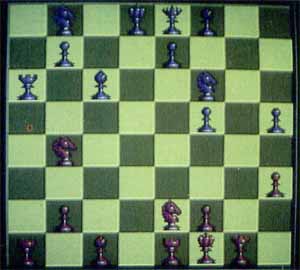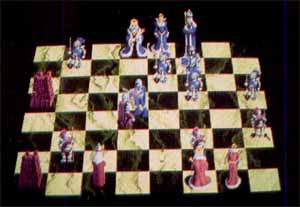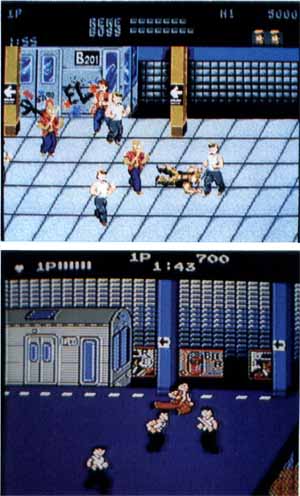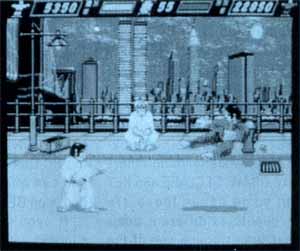 AME SHELF
AME SHELF|
LOST
DUTCHMAN MINE Magnetic Images Co.
P.O. Box 17422
Phoenix, AZ 85011
$49.95; Color only
Reviewed by Peter A.
Smith
|
 Lost Dutchman
Mine is a recent release from Magnetic Images in which you play
the
part of a grizzled prospector searching for the fabled mine of the
title. The game comes on two disks, is not copy-protected and can be
installed on a hard disk.
Lost Dutchman
Mine is a recent release from Magnetic Images in which you play
the
part of a grizzled prospector searching for the fabled mine of the
title. The game comes on two disks, is not copy-protected and can be
installed on a hard disk.AtmosphericaIly,Magnetic Images has gone the extra yard for this game. The graphics are cartoonish and well executed, the music is entertaining yet unobtrusive (with MIDI keyboards supported), and game play is punctuated by digitized sounds. I may as well note right off that Version 1.00 had a bug in the sound routine, which caused intermittent crashing, but Magnetic Images assures me that this problem has been fixed in Version 1.02.
You start the game in the town of Goldfield with $150. You must use this cash wisely to outfit yourself for exploration. Among your options in town (chosen by guiding your character into different buildings) are buying food and tools, having your gold assayed (turned into cash), or playing poker with Dapper Dan. If you choose the latter, you will find Dan is a fairly decent poker player and his digitized voice really sets the Old West mood.
As time passes, you will need to eat and drink in order to survive. The bottom third of the screen contains a series of icons dealing with cash, health, food, equipment, bullets and the disk. Clicking on cash or bullets shows you how much of each you have. The disk is for saving and restoring games. Clicking on health shows the number of wounds you've sustained, as well as bar graphs representing hunger, thirst and overall health. Clicking on the food icon allows you to eat any of your consumables with a resulting improvement in well-being. Unfortunately, you cannot view your health status and eat at the same time; this necessitates a lot of clicking back and forth to ensure that you've eaten enough without any waste. Last, the equipment icon shows assorted tools and ore carried.
Leaving town amounts to zooming out to an overhead view of the surrounding countryside, where you are portrayed by a square cursor. Using your joystick, you can head to wherever you'd like to search for gold. It's a good idea to visit the river first. There you can fill your canteens, fish for your dinner and pan for gold ore. While in the wilderness, hitting the fire button zooms you into a first-person view of the surrounding area; it is here that you can look for distant mines and caves.
When a mine or cave entrance is approached, a press of the fire button will take you inside, whereupon the view switches to a cutaway of the mine shaft with you at the mouth. While exploring the tunnels, you will find pockets of gold ore. Assuming you brought along a pickax, pressing the fire button will collect the ore. After you have all the ore you can carry, or all that you can find, it's time to journey back to town to get it assayed.
While wandering the wilderness you may be ambushed by a rattlesnake, Indians or bandits. Each encounter is handled in the same manner, offering a choice of running or fighting. If you choose to fight, your joystick will control a crosshair cursor in a first-person view. Use it to shoot your enemy before he shoots (or bites) you. A rattlesnake can be eaten in a pinch, and sometimes a dead bandit will net you a reward. Choosing to run is always a safe option, but if you are up against Indians or bandits you will forfeit your possessions.
Overall, Lost Dutchman Mine is well executed. However, the initial struggle to become well equipped is over all too soon, and gold becomes meaningless as you end up with huge amounts of money and nothing to buy. At this point, the search for the Lost Dutchman Mine is your only concern. Finding the needed clues takes persistence but can become boring. Once a few pieces of the puzzle are found, interest picks up again. After you find the mine and stake a claim, the game ends.
For $49.95, Lost Dutchman Mine, though nicely implemented, doesn't provide your hunger for adventure with much to chew on. I couldn't help feeling that I had tasted a great sauce without enough meat.
|
Battle Chess
Interplay Productions 1575 Corporate Drive
Costa Mesa, CA 92626 (714) 545-9001 $49.95; Color Only Reviewed by Frank Eva |
 |
Chess programs have been around for a long time. With so many of them on the market, one can't help but wonder why someone hasn't tried to add a little spice to this popular but genarally unspectacular game. Finally, someone has. Interplay's Battle Chess is a visual treat as well as a good version of the standard chess game.
The players' pieces are depicted in animated human form. The pawns and knights are actual soldiers dressed in medieval armor. The bishops took like miniature priests. The rooks (sometimes referred to as "castles") resemble stone watchtowers.
Actual digitized sound effects, such as clanking armor, accompany the animations. When an attack occurs, the animations depict a battle between the two pieces, and although each confrontation has a predetermined outcome, the fight is enjoyable to watch while plotting another move. Most battles are not without humor. When a pawn attacks another pawn, he lances his opponent in the foot; the crippled pawn then hops up and down on his good leg until the final death blow is struck. Then the conquered piece dissolves pixel by pixel and vanishes.
Rooks transform into huge living rock monsters that taunt their opponents when attacking. Some of the pieces put up a valiant struggle; others will simply drop their weapons in fear and wait for the inevitable. When a rook takes a queen, he tips her straight up in the air and swallows her down, whole!
The queen uses magic to do away with her opponents. At her command are lightning bolts and whirlwinds. The king has his own bag of tricks, including shooting an opponent with a gun ... foul play! When a knight meets his end, he does so piece by piece; there goes an arm ... now, a leg...another leg....
Other features include an opening library of 30,000 moves and the ability to play against the computer, a friend, or have the computer play itself. Also, a chess novice can take back moves or have the computer suggest one. Classic chess problems can be set up on the board so that seasoned players can hone their skills. There is even a replay feature, though I have my doubts about the value of such an option. After all, this isn't Monday-night football.
In Battle Chess, the computer's level of competence is determined by the length of time it's allowed to think. There are nine levels ranging from five seconds to more than 21 minutes. Another level allows input of a time limit from one to 10,000 minutes. The computer can be forced to make a move, even if it isn't quite ready.
 INTERPLAY'S BATTLE CHESS IS
A VISUAL TREAT
AS WELL
AS A GOOD
VERSION OF THE
STANDARD CHESS
GAME.
INTERPLAY'S BATTLE CHESS IS
A VISUAL TREAT
AS WELL
AS A GOOD
VERSION OF THE
STANDARD CHESS
GAME.
Rookies, like me, are probably more interested in a mode of play that simulates another human rookie. In other words, a mode in which the computer makes random mistakes and allows occasional advantages to go to its human counterpart. Battle Chess does not offer such an option, but it has one that is even better: modem capability. This makes any player who owns the game a potential opponent.

The program comes on two disks,which are not copyprotected. Interplay recommends copying the masters and playing with only the duplicates. A program is included that automates the process and includes the ability to combine both disks into one double-sided disk or load them onto a hard drive.
Nice functionality and great artwork, animation and sound effects all blend to make Battle Chess a real winner.
| RENEGADE TAITO SOFTWARE INC. 267 WEST ESPLANADE NORTH VANCOUVER, B.C. CANADA V7M 1A5 (604)984-3344 $29.95; COLOR ONLY REVIEWED BY STEVE PANAK |
 |
Often when I look at a game from a company I've never encountered before, I expect the worst. The general rule seems to be that the big publishers get all the good programs, leaving the smaller outfits to fight for what is left at the bottom of the barrel. Most of the small outfits end up fighting over table scraps. And while Taito is by no means a small concern, these musings come to mind because I've just started to look into their catalog and all their games are new to me. Hopefully, some of their future products will have a lot more to offer than Renegade. Not that Renegade is altogether bad; rather, it is undistinguished.
In each of the game's five levels, you battle against an onslaught of vicious henchmen who block your way to their gang leader. Each thug does his best to take you out, whether it be with a flurry of flying limbs or a well-placed club against your head. Your goal is as simple and primitive as the rules that govern play: survive.
To help you survive, you have only your fists and feet. Of course, a little street smarts helps as well. By moving the joystick, you navigate about on the screen. Pressing the button down activates any of a number of offensive moves, such as a back kick or a punch to the head. The only strategy that develops is the need to take out the men with weapons first and, of course, to keep moving. Standing still for even a moment invites attacks. With only three lives, each of which can stand only about nine hits, you don't want to invite attacks. You'll have enough uninvited ones.
As you deal with each thug, you'll find that it takes more than a knockdown to eliminate your opponent. Fortunately, a renegade makes his own rules, and the first one you might devise is that you do hit a man when he's down. That's what the crouch-and-punch move is for. Once beaten senseless, a hood finally disappears. But what about the half-dozen milling behind him? Only by getting past every opponent will you confront their leader.
Unfortunately, the game falters where it counts: graphics and control. The graphics are average, the animation uninspired. But while blocky images can be forgiven, a sloppy control interface cannot. Even though the control pattern is logically laid out and hence simple to learn, it never seems like you're in control. Move the joystick to jump kick, you end up punching. More infuriating is the fact that it doesn't let you direct your attack to the left and right. Rather, it forces you to fight only in the direction you last moved. You have to release the button and turn before you can attack the thug behind you. This costs valuable seconds you can't afford to spend. It would have been much better to be able to attack in all directions as controlled by the joystick movement. Don't get me wrong, you do learn, you will improve. I just didn't enjoy the game enough to try.
Another drawback is the limited longevity of Renegade. Once you've completed all levels, there is simply no where else to go. You can try to get more points, but I think by the time you get to the end, you won't care.
All things considered, Renegade is an average arcade game. I can take it or leave it. Take a look and decide for yourself.
| WORLD KARATE CHAMPIONSHIP EPYX, 600 GALVESTON DRIVE P.O. BOX 8020, REDWOOD CITY, CA 94063 (415)366-0606 $19.95; COLOR ONLY REVIEWED BY STEVE PANAK |
 |
After a
temporary absence from the software shelves(due to a copyright
infringement lawsuit), Epyx has rereleased the award-winning World
Karate Championship. And while this is not an event guaranteed
to stop
everyone in their tracks, it should inspire many a budding black belt
to don his or her ghia and bow to this honorable opponent.
As you might expect, the basic premise of Karate is
simple and straightforward. One or two players fight using the ancient
martial arts. Experienced players will become the masters of moves
ranging from a simple punch to flips and back-spin kicks. And although
the game is at its best when it sets two friends at each other's
throats, the single player will find the computer to be a worthy
opponent. Perhaps I should say a relentless and ruthless opponent. It
will take you quite a while to score any meaningful victories. Luckily,
a notable feature allows two players to gang up on a single foe. But
regardless of the skill of your adversary, all comers will find
something to interest them.
The graphics are superb, the sound bone-crunchingly
realistic, the action fast and furious. The little extras, such as the
stars spinning around the head of a prone casualty or the realistic
manner in which an unconscious body hits the ground, are what
distinguish Karate from all
the other fight games out there.
While the bulk of the screen forms the fighting
arena, the top of the display contains scoring and vital statistics. A
referee awards each hit or knockdown, the number of points based on the
difficulty and viciousness of the blow. Between each round are tests of
skill which must be completed before you are awarded advanced belts.
You may be required to avoid thrown knives or break bricks with your
head.
To keeps things visually interesting, the backdrops
for the arena are scenes from around the world. You will find yourself
fighting in places as gritty as the streets of New York or as exotic as
a desert island, complete with hula-dancing spectators.
All in all, the visuals are excellent and program
design good. Unfortunately, the game does have its drawbacks. The worst
aspect of the game is the long time it takes to become proficient at
it. This is due chiefly to the seemingly random way the control of the
many possible moves is arranged about the joystick. Even with all the
moves fully documented in the manual, it's too hard. It seems a better
arrangement would be to have all the movement options, including jump
and crouch, to be active when the button is released. Offensive moves
would require the button to be depressed and would be arranged
logically, perhaps with the two up diagonals activating high punches
and kicks, left and right controlling center kicks and punches and so
forth. Without a discernible pattern to aid memory, learning becomes a
nightmare.
Despite this obstacle to play, however, those who
stick with it will find World Karate
Championship to be an above
average game with a lot to offer. Whether you play it alone or with or
against a friend, it's a knockout.